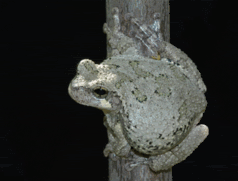
I recently received an “editorial email” from Tim Halliday, International Director of the Declining Amphibian Populations Task Force (DAPTF). I thought it important enough to paste two selections here.
“The Mission of the DAPTF is to determine the nature, extent and causes of amphibian declines throughout the world, and to promote the means by which declines can be halted or reversed.Most people shrug off news of what appears to be a remarkable, ongoing amphibian extinction. Many individuals believe the extinction is something biologists are predicting, some future worst-case scenario. Futhermore, most folks don't connect the dots; the worldwide amphibian decline and the increasingly publicized global fresh water crisis are related.
Last year’s Global Amphibian Assessment (GAA) brought to the attention of the wider world what those of us concerned with amphibian declines already knew. We are faced with a major extinction event, in the light of which our current mission statement seems increasingly unrealistic…
How should biologists act in response to mass extinction? I suggest that the first thing we should do is put more effort into alerting the wide world to the significance of amphibian declines. The general public, and its political leaders, seem indifferent to amphibians and are unimpressed by statistics on threatened species, however large the numbers. We need to emphasise that amphibian declines are a symptom of a rapid decline in the capacity of the environment, especially its freshwater component, to support life. We face an uphill struggle in getting this message across.”
Realizing that people are not responding to the alarm, Halliday takes a page from George Lakoff and suggests that a change in framing may be in order.
“A number of commentators have suggested that the public, and its leaders, are in a state of denial about environmental issues. The prospect of environmental collapse is too awesome, and too remote, to think about. I suggest that we biologists engage in our own form of denial by operating within the general area called ‘conservation biology’. This is a comforting, feel-good title but the results of the GAA suggest that we’re not doing a very good job. I now call myself an ‘extinction biologist’ and find that this generates much greater interest in what I do than calling myself a conservationist.”Whether or not the term "extinction biology" will rouse a somnambulistic public, amphibians are vanishing, and at an incredible rate. As many as 122 species have gone missing - and are presumed extinct - since 1980 and 32% of the remaining species are in danger of imminent extinction.
Photo credit: copyright, Virginia Natural Historical Society; image of Cope’s Gray Treefrog (Hyla chrysoscelis)

No comments:
Post a Comment